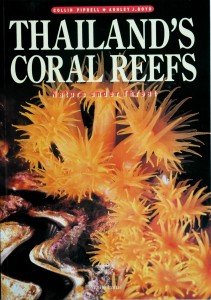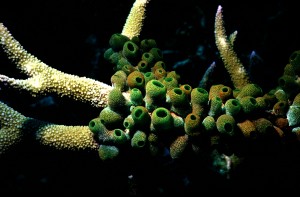Save the whales; save the gibbons. Yeah, yeah. But here’s how to help save the whole world. Be the first on your block to start ranching sea squirts. It seems these leathery wee bags with two openings and way-kinky social lives might be just what the doctor ordered when it comes to clean energy.
Back in 1995, at the request of White Lotus Press, I collaborated with photographer Ashley J. Boyd on a natural history of Thailand’s coral reefs, including their distribution and condition.
 Here’s something from the mini-field guide to local marine animals we included at the back of the book:
Here’s something from the mini-field guide to local marine animals we included at the back of the book:
ASCIDIANS (Phylum Chordata, subphylum Urochordatga)
These animals are more commonly known either as sea squirts or tunicates. ‘Ascidian’ is derived from askos, the Greek for ‘wine flask,’ and very often they do resemble leathery little bags with two openings — one to let in water bearing oxygen and plankton, and one to let waste water out. They can close one or both openings, but more often leave both open, with a stream of water passing continuously through. A 30-mm sea squirt can filter about one liter per hour (they range from several millimeters to several centimeters in size).
However primitive this description may make the sea squirts seem, they do in fact have stomachs, intestines and, being hermaphroditic, not only a testicle but an ovary too. The test surrounding these animals is supplied with blood vessels. The mantle has muscles by means of which the tunicate can open and close its siphons or contract the body as a whole.
Ascidians belong to the Phylum Chordata. Although they do not have a backbone, their larvae have notochords which help support muscular tails and which are evolutionary harbingers of the true backbones. The larvae also have gill slits, which would also seem to ally them more closely than their adult forms to the higher organisms. It is indeed thought possible that the tunicates are the ancestral chordate — ancestor, that is, to all of us.
In their adult phase the tunicates become sedentary (much like many humans), attaching themselves either singly or in colonies to the undersurface of rocks on the reef flat, to the roofs and walls of caves on the reef slope, and to the sides of holes and crevices. They also make some contribution to the consolidation of rubble caught in depressions around the reef rim (although ascidians can be found everywhere from the low tide mark to the ocean deeps as well).
Their social life is more interesting than one might grant at first glance. Besides propagating hermaphroditically, for example, some reproduce by budding. And individuals sometimes cluster around a single common cloaca, thus constituting ‘composite ascidians.’ So-called ‘social ascidians,’ on the other hand, remain united to the parent individual after budding.
Sea squirts are protected from humans by the fact they aren’t much good for anything (or so it was believed until it was discovered that some yield substances, such as didemnin B, which are helpful in the treatment of leukemia and tumorous growths). Their tough, leathery bags protect them from a variety of other predators, however, notably starfish and various species of mollusk. The sessile varieties, though, are often displaced by more competitive organisms such as sponges. In at least one instance, tunicates offer protective camouflage to another animal — some types of crab characteristically carry an envelope of sea squirts which may help protect the crustacean from its enemies.
There is a class of tunicates (Thaliacea) which are free-swimming. Ranging in length from a few centimeters to two meters in length, these animals are transparent, cylindrical or cone-shaped creatures sometimes mistaken for jellyfish.
Note the remark regarding their possible use to humankind:
Sea squirts are protected from humans by the fact they aren’t much good for anything (or so it was believed until it was discovered that some yield substances, such as didemnin B, which are helpful in the treatment of leukemia and tumorous growths).
As it turns out, however, these interesting critters, which quite possibly incorporate the evolutionary prototype for our backbones, could well have a greater role than that to play in the scheme of things. Here’s something an environmentalist friend and sometime diving companion from Bali just sent me:
Five researchers at the University of Bergen (UiB) and Uni Research say they found the marine animal tunicate could be used as a renewable source of biofuel. These marine animals serve as bacteria eaters and as a foodstuff in Korea and Japan right now, but the cellulose, the protein and the Omega-3 fatty acids in tunicate are the cause for its many uses.
“Its mantle consists of cellulose, which is a collection of sugars. When cellulose is cleaved, one can obtain ethanol. And ethanol can be used for biofuel in cars. The animal’s body consists of large amounts of protein and Omega-3. This can be used for fish feed,” says Professor Eric Thompson at UiB’s Department of Biology.
The researchers say they have already acquired a patent for biofuel and have a patent application pending for the cultivation of tunicate as fish feed.
Dr. Sc. Christofer Troedsson of Uni Research’s Molecular Ecology Group and head of the research at UiB’s Marine Development Biology and the tunicate research project said the bioethanol used today is unsustainable, as it comes from foods already used for human consumption.
“That is why there has been a move towards using cellulose from the timber industry to produce bioethanol,” Troedsson said. “However, it is quite complicated to break down the cellulose in trees and convert it into ethanol. This is because the wood contains a substance called lignin, which is hard to separate from the cellulose. Tunicates contain no lignin. Their cellulose is also low in crystals and is more efficiently converted into ethanol.”
He said using tunicate rather than trees is more environmentally friendly because it does not occupy large tracts of land that could be used for other purposes.
Tunicate, specifically the subspecies ascidiaces, is not in the food chain, so there are no creatures dependent on it to survive. They also grow quickly and are found in all oceans.
“We have spent years to arrive at these findings, so the prize is a nice recognition. Now we look forward to working on commercializing the results,” says Thompson.
Another ocean dweller scientists are looking at for a source of biofuel is algae. Last November, engineers from the University of Michigan said they “pressure cooked” algae for as little as a minute and transformed 65 percent of the green slime into biocrude, a process that typically takes Mother Nature millions of years. Researchers believe an area of algae the size of New Mexico could provide enough oil to match current US petroleum consumption.
So what can we learn from all that? First, it’s clear we need to show more respect for our fellow creatures, no matter how obscure and apparently insignificant. Global extinction rates are currently running at tens of thousands of species per year, and many of these creatures are disappearing forever because of careless human activity. Even if we put aside their intrinsic value and interest as unique expressions of our world’s creative emergence, we just never know when a species is going to prove useful, even commercially valuable.
So guess where I’m putting all my money. Sea squirts rool, OK!
“Aha,” says my Sara, in what might be an admiring tone. She knows I didn’t get where I am today by being blind to trends.
Thailand’s Coral Reefs (Bangkok: White Lotus, 1995), by Collin Piprell. Photos by Ashley J. Boyd. Natural history and conservation of reefs. Out of print.
Tunicate photo by Ashley J. Boyd.


Should have said: I’m kidding when I suggest everyone should run out and start ranching tunicates. Those cited in the article have spent years and considerable resources finding a way to do this commercially, and await the award of patents.
A pity. Cattle ranching is messy, and I don’t really have enough land. Or any, come to that. Cattle rustling, meanwhile, is so déclassé. Or so Sara claims.
Another possible fix? http://scitechdaily.com/discovery-may-lead-to-the-creation-of-biofuel-from-co2-in-the-atmosphere/
Tunicates may have much to offer us, and so far they don’t appear to be threatened with extinction, at least no more so than the rest of us. But turtles are the most endangered group of major vertebrates; and science is only beginning to understand how important they might be. http://scitechdaily.com/painted-turtle-genome-reveals-clues-to-extraordinary-adaptations/